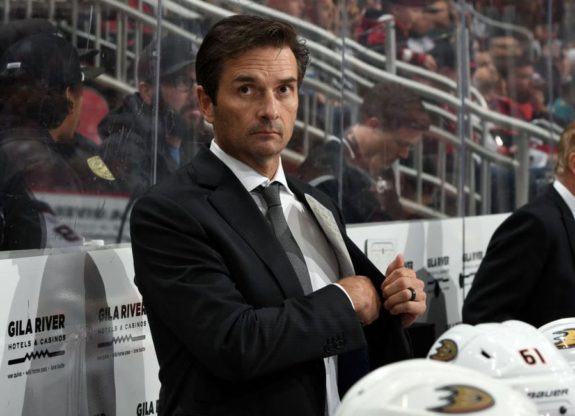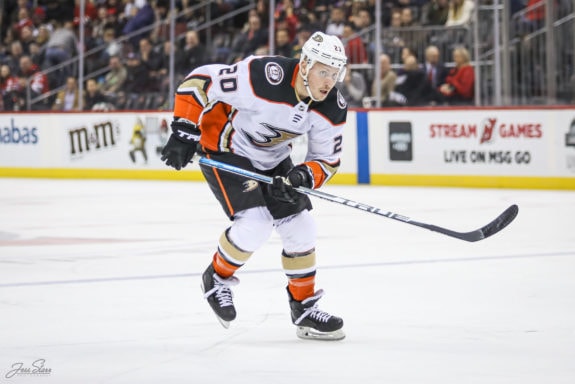The Anaheim Ducks’ series versus the Minnesota Wild saw the team, mostly thanks to John Gibson, earn their first win of the season. Sadly, Anaheim lost the second game to split the series in a matchup that demonstrated that the Ducks’ top players just aren’t getting the job done this season, while their depth players continue to keep the team in games. It’s a development that will need to change if the Ducks are going to climb out of the hole they’ve already dug themselves.
Ducks Need Faster Starts
Their first two games against the Vegas Golden Knights saw the Ducks struggle in the first period’s opening stretch. That trend continued against the Wild. Though they didn’t find the back of the net in Game 1, the Wild dominated possession, compiling a Corsi-for percentage of 60% in the first period. That huge disadvantage in shot attempts had the Ducks scrambling in their zone to start the game. If it weren’t for Victor Rask missing a wide-open net, the Ducks might have been trailing in the first period for the second time in three games.
Wednesday night held much of the same. By the time the first period mercifully ended, the Wild had outshot the Ducks 16-6. They were lucky they only trailed by a goal after a power-play miscue between Jakob Silfverberg and Kevin Shattenkirk resulted in a Ryan Hartman breakaway goal.
If the Ducks don’t turn around their first-period play, they’ll be playing 2020-21 with a hand tied behind their back.

It’s a well-known fact in all sports that scoring first and protecting a lead is easier than chasing one. The same goes for hockey. Teams change their offensive and defensive strategy when protecting a lead versus chasing one, and the numbers bore that out last season. The Ducks won 73 percent of games in which they scored first and lost 68 percent of games in which they didn’t in 2019-20. In their two games against the Wild, they won the game in which they scored first — and were lucky to do it— and lost the game in which the Wild scored first.
Shattenkirk a Mixed Bag
Though Shattenkirk tallied his first point of the season in Game 1 versus the Wild, his performance overall left a lot to be desired, especially in Game 2.
First, let’s explore the good.
Shattenkirk showed off his trademark passing ability when he assisted on Nic Deslauriers’ first goal of the season and the only goal of Game 1.
He demonstrated that he’s not afraid to join the offense when he flew up the right-wing to take a pass from Carter Rowney before threading the needle right to Deslauriers. Shattenkirk showed Ducks fans part of why general manager Bob Murray has been after him since last offseason.
Shattenkirk Sets up Shop in the Penalty Box
But Shattenkirk’s play in Game 2 erased the positive development of the game before. As mentioned above, his miscue with Silfverberg resulted in the Wild’s first goal of the game.
Though Silfverberg’s ill-advised no-look pass deserves more of the blame for the goal, Shattenkirk’s lackadaisical effort to poke the puck away from Hartman played a role.
On top of that, Shattenkirk took three penalties. His second penalty allowed Nick Bonino to score the Wild’s second goal on the ensuing power play. His third penalty came off a misfire that landed on the stick of Kirill Kaprizov, who then turned Shattenkirk inside out for a contested breakaway that forced the Duck defender to slash the young Russian.
Rather than help the Ducks’ power play, he spent nearly one-tenth of the game in the penalty box and handed the Wild three man-advantage opportunities.
The Ducks are now 0-for-7 on the power play with a record of 1-2-1, thanks in part to Shattenkirk’s struggles this season. If the Ducks want to compete, he will need to turn around his play drastically. Perhaps, without Victor Hedman and Mikhail Sergachev on the defensive corps with him, as they were in Tampa Bay, the veteran defenseman is struggling to adjust to his increased role.
Bottom Six or Top Six
Someone’s grabbed the Ducks lineup card and flipped it. In terms of point production and overall play, up is down and down is up.
The Ducks’ forwards who manned the top two lines against the Wild – Rickard Rakell, Silfverberg, Danton Heinen, Sonny Milano, Ryan Getzlaf, and Adam Henrique – scored no points in the series. The Ducks’ “top-six” forwards were nearly invisible.
Meanwhile, the bottom two lines of Sam Steel, Max Comtois and Troy Terry, and Nicolas Deslauriers, Carter Rowney and Derek Grant have had the better of the play. The fourth line of Deslauriers, Rowney and Grant played a role in all three goals in the Wild series, with Deslauriers scoring two and adding an assist on Cam Fowler’s first goal of the season.

The Ducks’ fourth line has been one of the more exciting checking lines in hockey since their time together began in 2019-20. The third line has shown some chemistry and offensive ability as well, even if they surrendered the Wild’s game-winner Wednesday night.
Comtois, Steel and Terry repeatedly generated chances in the offensive zone and gave the Wild a hard time breaking out of their own zone in both games.
It’s great to have secondary scoring, but that’s all the Ducks seem to have so far this season, further highlighting their desperate need for the potential of a player like Trevor Zegras, who might provide a spark that could help the top lines produce.
The Ducks have started 2020-21 badly. They continue to fall behind early in games, their power play futility has continued, and their top players have been nearly non-existent. If the Wild series showed us anything, it’s that it’s time to turn this team over to the youngsters that are not just currently on the roster, but coming up through the system.
all stats from naturalstattrick.com and hockey-reference.com